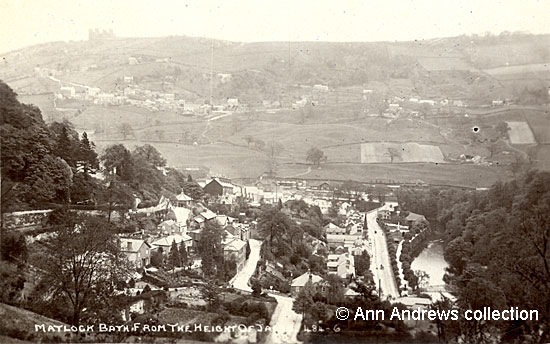|
Images Index> Matlock Bath, 20th and 21st Century Images> This page |
| Matlock Bath from the Heights of Jacob, 1920s |
| Matlock Bath : Twentieth Century Photographs, Postcards, Engravings & Etchings |
|
|
||||||||||||
At the same time as the Ashfield sale, Matlock Bath UDC held a special meeting to discuss what was heralded as a great improvement for Matlock Bath. They agreed to construct a road 25 feet wide through the Temple Hotel Estate to widen Waterloo Road, which had previously only been accessible via the Pitchings. The stiff climb was said to be a trial for most strong people and extremely difficult for invalids. The new road plan was thanks to the largesse of Mrs. Wheatcroft. She had agreed to give the Council a butchers's shop in Waterloo Road, a strip of land 10 feet wide and some other pieces of land. When finished the works were to be "dedicated to the public for ever", although it was not clear when the work was to be undertaken[3]. The work was not completed until about 1922 and "New Road" is shown on the O.S. map for that year[4].
The limestone retaining boundary wall with Ashfield can be seen next to the drive. Next door is Belmont which had been the home of Ernest William Barnes[5] for a number of years. Following his marriage at Holy Trinity on 7 Jun 1923 to Mrs Maude Garbutt, who was the organist at Bonsall Church, he and his wife went to live in Southport for a time but returned to Matlock Bath[6]. Ernest Barnes worked as a reporter for two local newspapers, the High Peak News and the Matlock Guardian. Barnes and his editor were accused of slander by the local politician Charles Frederick White in the second decade of the twentieth century. Although proceedings began in 1911 the case was not resolved until 1914 when White lost and was financially ruined[7]. Ernest's brother was John Herbert Barnes, the Barnes who formed the Barnes Quadrille Band. He, too, was a journalist and had been a schoolmaster at Heage[8]. Belle Vue House, next to Belmont and with the garden seat on the terrace, was still the home of the Donegani family when the picture was taken. Mrs. Pamela Donegani was letting out apartments in 1922 and she and her husband were still there in 1928. The last two members of the family to live at Belle Vue House were Dora Helene Donegani (Dora) who died in 1953 her sister Josephine Frances (Josie) who continued to to live there until her death in 1963. Belle View can also be seen on Adam's lithograph. On the right hand edge of the enlargement is Wellington House, where John Herbert Barnes passed away[8]. Robert Baguley advertised apartments there for a time, although by 1927 Adria (nee Donegani) and John Swift ran the boarding house. Adria's father, Joseph Francis Donegani, had bought the property for his daughter from Mr Baguley[9]. Close to the far back corner is Belle Vue Cottage which is actually on the sharp bend in Waterloo Road. It had been the home of -- Nicholls, but the Hatton family moved there. They had lived previously in Derby but moved away during the First World War following a bomb dropping on the Arboretum, which was close to where they lived. This was their second home in Matlock Bath[9]. A maid is looking over the wall on Upperwood Road, standing opposite the entrance to the Lower Towers (top left). The large stone that used to be outside the Round House - used for dismounting from the donkeys that visitors to the Heights had hired - seems to be to the right of the front door of the octagonal dwelling. All of these properties, apart from Wellington House, are Grade II listed today (2017).
|
|||||||||||||
1. and 2. "Matlock Bath from the Heights of Jacob". [Photo by Jamson jnr.] The Doncaster Rotophoto Co. Ltd., No.484.6. Danum Series. Real Photograph. Unused. Both images © Ann Andrews collection. Information researched, written by and © Ann Andrews. Intended for personal use only. |
|||||||||||||
References (coloured links are to transcripts or more information elsewhere on this web site): [1] See both William Adam's "Gem of the Peak" and Chapter 4 of Hall's "Days in Derbyshire". [2] "Derbyshire Advertiser and Journal", 9 October 1908. Property Sale. [3] "ibid.", 9 October 1908. Great Improvement in Matlock Bath. Special meeting of Matlock [Bath] UDC. [4] Ordnance Survey County Series Maps, Derbyshire, 1922. 1:2,500. [5] Ernest William Barnes can be found in the 1871 census (on North Parade, although it does not say so) | the 1881 census | the 1891 census | the 1901 census (by now living at Alpine House/Belmont). He also advertised, when living at Belmont, in Kelly's Directory 1908 | Kelly's Directory 1912 | Kelly's Directory 1916. [6] "Derbyshire Times", 9 June 1923. in Southport in 1933 but was back at Belmont in 1935. He died at Bournemouth during the Second World War. [7] "Derby Daily Telegraph", 20 February 1914. The case of Mr. C. F. White. Appeal to the Lords. "White v. Barnes, which has already engaged the attention of the King's Bench and the Court of Appeal". The case was widely reported in the press and had cost over £1,000, money Mr. White did not have. His debt was finally cleared in 1918 and he became an M.P. [8] John Herbert Barnes died at Wellington House, in Mrs. Swift's care, in 1927. He was unmarried. See his MI. [9] Recollections of the late Mr. Frank Clay,
from private papers and notes owned by Mrs. Doreen Buxton, some of
which were written in 1992 and are still within copyright. The Hattons
were his maternal grandparents. |




 River
Derwent & the Devonshire Hotel, 1890
River
Derwent & the Devonshire Hotel, 1890 River
Derwent, 1950
River
Derwent, 1950 Road
Widening
Road
Widening Donegani
Family Portrait
Donegani
Family Portrait Matlock
Bath Business Letterheads
Matlock
Bath Business Letterheads